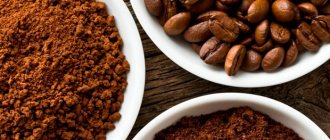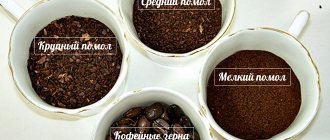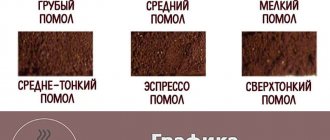Regardless of the type of coffee grinder you have, whether it is mechanical or electric, its purpose is to perform a single function - grinding coffee beans. However, particularly savvy ordinary people are so smart that they have significantly expanded the range of capabilities of this device. What can be ground in a coffee grinder other than coffee, and how its incorrect operation will affect the device will be discussed further.
Which model is suitable
From a theoretical point of view, it is possible to grind anything in a coffee grinder. However, in practice, a number of nuances arise. When purchasing a device from a retail outlet, carefully read the manual that comes with it. In it, the manufacturer must specify what the coffee grinder can be used for and what products besides coffee you can process.
Important! If the device is used as a multifunctional shredder without sufficient knowledge of the rules of its operation, there is a risk of damage to the basic mechanism due to improper handling.
Of all the types of coffee grinders, the most versatile option is the burr grinder. With its help, you get the opportunity to adjust the grinding fraction. This option is extremely important, since some products require grinding to a powder state, while others require coarse grinding.
As a budget alternative, you can use a knife electric coffee grinder. However, the functional characteristics of the device will be determined by the specific modification depending on the quality of the blades and performance.
Recipe
- Before grinding, the coffee grinder should be thoroughly washed and dried with a paper towel . If particles of previously ground products remain on its walls, they will get into the powder and ruin both its appearance and taste. Coffee aromas are absorbed especially quickly.
- Pour the required amount of sugar into the coffee grinder and grind for 1 minute .
- Sift the resulting powder through a fine strainer . This will help remove large sugar crystals.
- Powdered sugar is a hygroscopic product. This means that it quickly absorbs moisture and clumps. Therefore, it should be stored in a glass jar with a tightly screwed lid, at temperatures up to 40 degrees above zero and at a humidity of no more than 75% .
What products is a burr coffee grinder suitable for?
The operating mechanism of this coffee grinder is a complex of toothed cylindrical millstones made of steel, placed at a certain interval relative to each other (in some cases in a spiral) and rotated in a one-to-one direction.
Products that penetrate the space between the teeth can be ground. The size of the particles formed depends on the size of the gap and the number of revolutions of the rollers. According to gourmets, the taste of coffee ground in this way is significantly superior to the quality of the drink made using blender blades.
Burr-type coffee grinders cannot be called cheap, but they can perform many tasks:
- Grind coarse salt, in particular sea salt;
- Grind the cereal into powder;
- Grind the hard spices into a fine powder;
- Crush peas, beans and other ingredients to make puree.
However, there are also more complex problems that such a grinder cannot solve - grinding poppy seeds for kutya. Moreover, this is due not only to the technical features of the device. To understand why this type of ingredient cannot be ground in a coffee grinder, you should consider the technology of its processing: poppy seeds for kutya are ground wet until a whitish juice appears, similar to milk of the poppy, which is absolutely incompatible with the principle of operation of the device. For these purposes, the best choice is a mortar and pestle.
A burr coffee grinder is suitable for nuts and spices, but it is not designed for grinding moist and juicy products. Particles of such components are characterized by increased viscosity, so they stick to the teeth of the mill rings in the form of a sticky mass and clog them. As a result, the rubbing elements are not able to efficiently perform their assigned functions, the intensity of their wear increases and soon there is a need to replace the coffee grinder.
In order to fully clean the device from the remnants of such a mass, it will need to be partially dismantled, freeing the components of the millstones. The coffee grinder is optimally suited for grinding bulk products and exclusively them.
Selection of coffee beans
Before grinding the grain, it must be selected correctly. The following external features of grain when purchasing will help you make a wise choice:
- Package. In stores - multi-layer thick, opaque foil, when purchased in bulk - paper bags.
- Appearance of grains. You can evaluate it when buying by weight. Ideal grains are whole, without chips, and approximately the same size.
- Grain density. Dry, hard, should split easily. If possible, you should ask the seller for a grain and bite it - a high-quality one will crack without any problems.
- Price. Good coffee cannot be cheap. The price of a kilogram starts from 1500-2000 thousand rubles.
To examine the quality of grain in all respects, it is better to buy in specialized shops where they are sold by weight. This will make it possible to evaluate the aroma, appearance, and degree of roasting.
Advice. When buying coffee beans, do not stock up on them for a long time. It quickly runs out of steam, so it is better to take a volume of grain designed for a maximum of a month.
What can a manual coffee grinder do?
This type of grinder has a number of advantages compared to an electric coffee grinder: its cost is an order of magnitude lower, its use does not involve the consumption of electricity, and its functionality is a little more extensive. Since the design does not use electrical mechanisms, it is completely safe to crush ice. At the same time, thawed particles will not lead to the creation of any unforeseen situations.
It is easy to make powdered sugar in a manual machine. To understand why you can’t grind sugar in a rotary coffee grinder, let’s look at the process in more detail: at high rotation speeds, sugar grains heat up and gradually take the form of a sweet syrup, after which crystallization and clogging of the working unit occurs, which in turn disables it. There is no such danger in a mechanical device.
With a manual coffee grinder you can:
- Grind the coffee beans;
- Grind dried mushrooms into fine crumbs for use in sauces and spices;
- Grind cereals and legumes, in particular peas for making soup or puree;
- Make breadcrumbs.
The device will prove to be an indispensable companion for mothers during the period of complementary feeding of the baby, especially when preparing dry milk formulas and cereals.
Using a Shredder
If you absolutely don’t have time to grind nuts manually, you can use grinders. Their role is usually played by a meat grinder, coffee grinder, etc.
You should pour nuts into the coffee grinder in small portions, and turn on the machine intermittently. That is, they turned it on, held it for 5 seconds, turned it off, and turned it on again. This way you will get fine crumbs. If you turn on the coffee grinder for a long time without a break, the nuts will turn into an oily mixture.
You can also grind fruits using a meat grinder; you just need to pass them through the meat grinder several times.
In this way you can grind walnuts and grind peanuts.
What should not be ground in a coffee grinder?
There is a list of foods that cannot be ground in any type of grinder, regardless of model, price, or brand.
- Nuts and seeds contain a large amount of fat, which is actively released during the crushing process. The thick, oily mixture clogs the internal components and creates a stubborn film on them that is difficult to clean.
- Grinding sugar to a powdery state is possible only with the help of a mechanical device.
- It is better to grind hard cheese only on a grater. When using a coffee grinder, it turns into a homogeneous viscous consistency.
Excessively hard foods are more likely to break the blades than become ground. However, you can still grind cereals in a coffee grinder, provided they are pre-soaked.
- Berries and fruits with seeds.
- Unprocessed foods, such as vegetables or meat.
Important! The manufacturer assumes responsibility only in those cases specified in the manual. If the device breaks down while working with unacceptable products or non-compliance with the technological process, warranty service is not provided. There are many training videos on the Internet on how to use a coffee grinder to prevent technical damage.
What is nut flour made from?
Nut flour is finely ground nuts and is prepared from the cake that remains after the production of nut butter. The cake is dried with hot steam and nut flour is obtained. In this case, nuts can be either roasted or raw, which affects the taste and nutritional properties of the flour. Basically, nut flour is made from peanuts, almonds, hazelnuts, cashews, pistachios, walnuts and pine nuts, and sometimes ground seeds and dried fruits are added to it for taste. If you use pistachios, use unsalted or lightly salted nuts - these can be found in stores. Nut flour is very healthy because it contains proteins, vitamins, minerals and fatty acids, improves the functioning of the heart, liver and kidneys, does not contain harmful cholesterol, strengthens the immune system and restores strength after heavy physical activity.
In cooking, nut flour is used as a tasty and aromatic thickener for sauces and doughs; it is added to yoghurts, salads, snacks and hot dishes; porridges and desserts are prepared with it. Walnut flour gives dishes a subtle nutty aroma, exquisite taste and increases their vitamin value.
Blender or coffee grinder
When choosing a kitchen chopper, you should determine the intended purpose of the device: whether it is possible to grind specific categories of products in it, and what loads it is designed for. The design of a blender is in many ways similar to a coffee grinder. The only difference is that its blades are higher and at a greater distance from the walls of the working container. In theory, this device is capable of grinding coffee beans, but in this case the beans settle at the base of the bowl and do not have time to return under the knives, as a result of which the grinding becomes uneven.
On a coffee grinder, the millstones are installed close to the bottom, and during the grinding process, the grains are again pulled up from below and ground. Thanks to this, a certain circulation of the contents in the container occurs. This ensures uniform grinding.
To grind coffee beans using a blender, you will need a suitable container with blades and a lid, otherwise they will fly everywhere. As a rule, such equipment is intended for grinding initially soft ingredients, while a coffee grinder is easier to process hard ones, and the better the millstones in its design, the harder the products can be ground.
The body of the latter is made primarily of metal material, but the working flask of the blender is made of polymer. Coffee beans that bounce off the blades can crack or scratch the bowl, which is also a negative aspect of using it to grind coffee.
The permissible power of the coffee grinder varies in the range of 140-220 W. And the productivity of a modern blender in minimum terms is 350 W, and in nominal terms – 800 W. If you grind beans at high power, they will become hot and burn.
So, a coffee grinder is definitely more suitable for grinding coffee. But for grinding other products, for example, purees for a baby, it is more advisable to use a blender, since the coffee grinder is quite difficult to wash afterwards and foreign odors and small particles are sure to remain in it.
Instructions for grinding beans
The easiest way to grind is in a rotary apparatus:
- open the lid;
- pour grain into container;
- plug the device into the outlet;
- note the time (different grinding times require different numbers of seconds);
- press the button;
- turn off the device;
- open the lid and pour out the prepared powder.
But you can’t set up a coffee grinder of this type. The degree of grinding here is adjusted using the grinding duration. There are significant drawbacks: grinding in any case turns out to be uneven; when grinding for a long time, the knives heat the grain, as a result it gives off some of the aroma at this stage.
In a millstone machine, you first need to adjust the grinding of the coffee grinder by adjusting the distance between the millstones. The rest of the process is similar. The grain is poured into a special container, the machine is turned on, and then the finished product is taken out.
Features of grinding various food ingredients
Coffee grinder for spices
Any aromatic food additives can be easily ground with a coffee grinder. However, after processing them, you should thoroughly rinse the corresponding compartment so that the future coffee drink does not turn out to be cloyingly acrid or bitter.
When using the device for a long time, the smallest crumbs of pepper, cinnamon and other components may become clogged in the internal chamber of the coffee grinder. Replaceable nozzles and a retractable compartment will help prevent the appearance of unwanted aroma inside the device. However, they are not provided in every rotor design. In general, using a coffee grinder as a grinder for spices and seasonings is acceptable, but such a decision is purely individual.
Basic principles of grinding spices:
- Do not fill the container more than 35-50% of its maximum capacity. This will prevent food from sticking to the cutting part and eliminate excessive load on the engine.
- Before grinding spices in a coffee grinder, heat them on a dry baking sheet. This way they will better demonstrate their taste and aroma properties.
- Coffee grinder for powdered sugar and salt
Absolutely any coffee grinder is suitable for grinding salt, but it is more advisable to entrust the grinding of sugar to millstones and hand tools. Grind sugar in a rotary mill with extreme caution, releasing the pressed button from time to time. Otherwise, the ingredient may melt, and the result will not be powder, but cotton candy.
Coffee grinder for cereals
To determine whether it is possible to grind cereals in a coffee grinder, you should pay attention to the principle of its operation. Due to the increased rigidity of the structure, grinding such products in a rotary device is quite dangerous, and therefore it is recommended to pre-soak cereals in water and dry them immediately before grinding. In electric type devices it is possible to process oatmeal and buckwheat. However, for fine grinding of rice, peas, pearl barley and other durum varieties, only a burr mill is allowed.
Coffee grinder for crackers
You can grind breadcrumbs into flour for breading in any grinder, but if the bread is very dry, it can dull the knives of rotary devices, this should be remembered. When using burr and hand coffee grinders, no difficulties with bread crumbs are observed.
Nut grinder
Despite the peculiarities of their structure, almost all types of nuts and seeds can be crushed without special requirements. Do not fill the compartment space above 35-40%, otherwise it will not be possible to achieve high-quality grinding. It is highly undesirable to grind excessively fatty nuts in rotary-type devices, such as walnuts, pecans and others, since an oily layer appears on their surface, which can negatively affect the functioning of the device.
Before grinding, you should first remove the shell from the ingredients. So, when processing walnuts in a coffee grinder, it is necessary to remove all membranes. As with spices, additional heat treatment and dry roasting will enhance the taste perception and reveal the aroma of essential oils.
Spice mill
The spice mill is designed for grinding spices. The design and volume of the mechanical unit are different, but this tool is usually not designed for large batches of product. In a mill you can grind a small amount of grains, which is enough for one brew. As in the case of a meat grinder, for better results the operation is repeated several times. The grind will be medium.
Hand mills are most often made of wood, which absorbs odors well. The aroma of spices is unlikely to spoil the coffee, but you will no longer be able to enjoy the pure taste of a rare type of Arabica or Robusta. In addition, after grinding flavored varieties, the mill will be very difficult to clean.
Disadvantages of using kitchen appliances:
- danger of overheating;
- failure of cutting parts;
- reduced service life;
- persistent odor that is difficult to get rid of.
Georgian sauce Bazhe for meat and poultry
In Georgia, every housewife knows how to prepare this sauce, and it is served along with meat as a gravy for a side dish. The sauce should be white and thick, and according to Georgian tradition, selected light walnut kernels are used for it.
For the sauce, it is not necessary to make fine flour, so the nuts do not need to be pre-dried in the oven - just grind them as finely as possible in a blender or coffee grinder, you can grind the nuts in a meat grinder or crush them in a mortar the old-fashioned way. Next, mix nut flour, half a teaspoon of salt and 6-7 crushed small cloves of garlic in a blender bowl, and then pour in a little warm boiled water. Whether to add spices is a matter of personal taste. Many chefs believe that the aroma of garlic and nuts is enough, and some lovers of Georgian spices use pepper, saffron, hops-suneli and utskho-suneli. Pour the juice of half a lemon into the nut base and do not use vinegar, as is recommended in some recipes, since vinegar will darken the nuts and the sauce will not turn out white. Now gradually pour in warm boiled water until the sauce acquires the consistency of kefir - in total you will need about 1½–2 glasses of water.
In Georgia, pieces of chicken or fish are sometimes placed directly into the sauce; it is no less tasty with vegetables, bread and aromatic flatbreads. Nut sauce will transform the taste of any dish, and some lovers of Georgian cuisine eat it with spoons or spread it on bread - it’s delicious!











